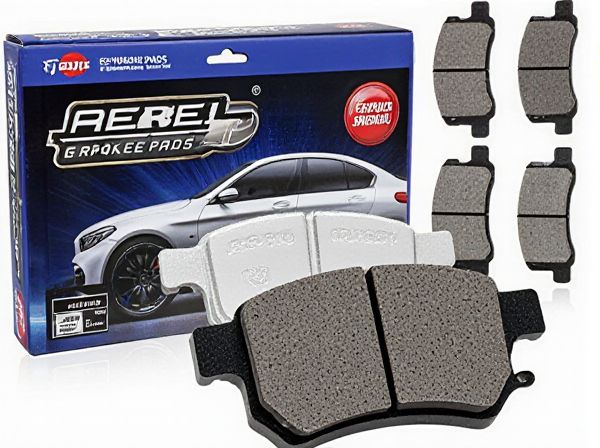
Photo illustration: Ceramic Pads vs Semi-Metallic Pads
Ceramic brake pads offer quieter performance and produce less brake dust, making them ideal for everyday driving and maintaining clean wheels. Semi-metallic pads provide superior stopping power and heat dissipation, which benefits aggressive driving or heavy-duty use. Your choice depends on whether you prioritize noise reduction and durability or high performance and braking efficiency.
Table of Comparison
| Feature | Ceramic Brake Pads | Semi-Metallic Brake Pads |
|---|---|---|
| Material Composition | Ceramic fibers, bonding agents | Metal fibers (steel, copper), resin |
| Performance | Quiet braking, stable under heat | High friction, effective in cold |
| Durability | Long lifespan, low wear | Moderate lifespan, higher wear |
| Heat Dissipation | Moderate heat resistance | Excellent heat dissipation |
| Noise Level | Low noise, less vibration | Can be noisy at times |
| Dust Production | Minimal brake dust | Produces more brake dust |
| Cost | Higher price | More affordable |
| Best Use | Daily driving, city use | Performance, heavy-duty applications |
Introduction to Brake Pads: Ceramic vs Semi-Metallic
Ceramic brake pads consist of dense ceramic materials combined with copper fibers, offering quieter operation and less brake dust compared to semi-metallic pads. Semi-metallic brake pads contain a blend of metals like steel, iron, and copper, providing excellent heat dissipation and durability under high-performance conditions. Choosing between ceramic and semi-metallic pads depends on factors like driving style, noise tolerance, and brake system compatibility.
What Are Ceramic Brake Pads?
Ceramic brake pads are composed of dense ceramic materials combined with fine copper fibers, offering superior heat dissipation and quieter braking performance compared to traditional pads. These pads produce less brake dust, reducing wear on wheels and maintaining a cleaner appearance, while providing consistent stopping power under a wide range of temperatures. Ceramic brake pads are ideal for everyday driving due to their durability, low noise levels, and minimal rotor wear relative to semi-metallic brake pads.
What Are Semi-Metallic Brake Pads?
Semi-metallic brake pads consist of a mixture of metals such as steel, iron, and copper combined with friction modifiers and fillers, designed to offer enhanced durability and heat dissipation. These pads provide superior braking performance under high temperatures, making them ideal for heavy-duty driving and performance vehicles. While they generate more noise and cause increased rotor wear compared to ceramic pads, their cost-effectiveness and reliable stopping power remain preferred by many drivers.
Performance Comparison: Stopping Power
Ceramic pads offer consistent stopping power with less brake dust and smoother braking performance, ideal for everyday driving conditions and lower noise levels. Semi-metallic pads provide stronger initial bite and better heat dissipation, delivering superior stopping power during aggressive driving or heavy-duty use, making them preferred for high-performance and towing applications. Both pad types require proper bedding to maximize performance, but semi-metallic pads generally outperform ceramic options in extreme braking scenarios.
Durability and Longevity Differences
Ceramic brake pads offer superior durability and longevity due to their composition of dense ceramic fibers and nonferrous filler materials, which resist wear and maintain performance under high heat conditions. Semi-metallic pads, containing a blend of metal fibers like steel, copper, or iron, wear faster because their metal content generates more heat and friction during braking. As a result, ceramic pads typically last longer, providing consistent stopping power over extended periods compared to semi-metallic pads that require more frequent replacement.
Heat Dissipation and Fade Resistance
Ceramic brake pads excel in heat dissipation due to their dense composition, which allows for consistent performance under high temperatures, reducing the risk of brake fade. Semi-metallic pads contain metal fibers that enhance heat conductivity but can retain heat longer, sometimes causing quicker fade during prolonged braking. This makes ceramic pads more suitable for maintaining fade resistance in daily driving, while semi-metallic pads perform better in high-stress conditions like aggressive or track driving.
Noise and Dust Levels: User Experience
Ceramic brake pads generate less noise and produce significantly finer dust compared to semi-metallic pads, enhancing overall driving comfort and cleanliness. Semi-metallic pads tend to be noisier due to their metal content, which can cause squealing or grinding sounds, and their dust is coarser and more abundant, leading to frequent wheel cleaning. Users often prefer ceramic pads for quieter operation and reduced brake dust accumulation, making them ideal for everyday driving conditions.
Cost and Affordability Comparison
Ceramic brake pads generally cost more than semi-metallic pads due to their advanced materials and quieter performance, but they offer longer lifespan and less dust accumulation, which can reduce maintenance expenses over time. Semi-metallic pads are more affordable upfront and provide excellent heat dissipation and durability, making them a popular choice for budget-conscious drivers and high-performance needs. Choosing between ceramic and semi-metallic brake pads depends on balancing initial cost with long-term savings and driving conditions.
Best Applications: When to Choose Each Type
Ceramic brake pads excel in providing quiet operation, low dust production, and excellent performance in everyday driving and light-duty vehicles, making them ideal for city commuting and highway cruising. Semi-metallic pads offer superior heat dissipation and durability, suited for heavy-duty applications such as towing, off-roading, and aggressive driving where higher friction and resistance to brake fade are essential. Choosing ceramic pads benefits drivers prioritizing comfort and clean wheels, while semi-metallic pads are preferred for enhanced braking performance under high-stress conditions.
Conclusion: Which Brake Pad Suits Your Needs?
Ceramic brake pads offer quieter operation, less brake dust, and longer lifespan, making them ideal for daily commuting and light driving. Semi-metallic pads provide superior heat dissipation and braking performance, suited for heavy-duty vehicles and aggressive driving conditions. Choose ceramic for comfort and low maintenance, or semi-metallic for durability and enhanced stopping power.
 caratoz.com
caratoz.com